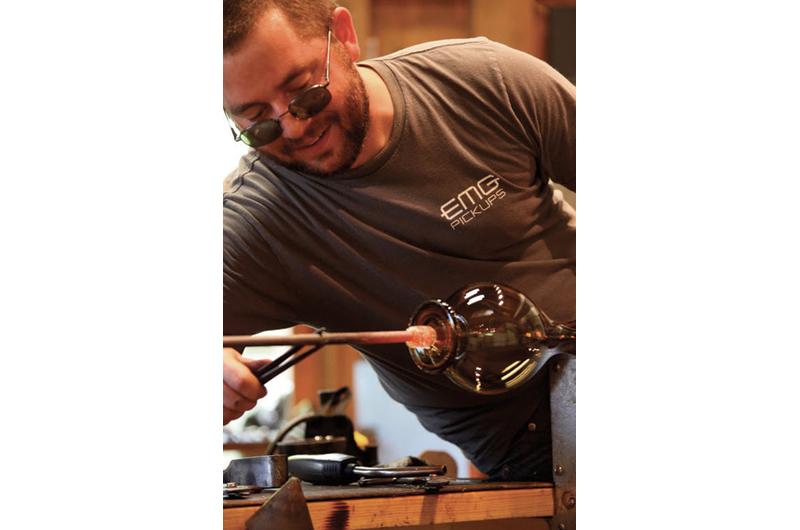That’s some cold heat,” remarked Russell Carson, standing at the “glory hole” – the fiery mouth where glass is reheated during blowing. Brittany Barry, a sometime collaborator, nodded. Collaborator, not assistant, because Carson’s world is about “we” not “me.” Other local collaborators, “his main homies,” include Joey Huang and Wil Sideman. The cold heat, a hundred degrees cooler than other glory holes on the American glass scene, allows for a more generous window of time in which Carson can slowly and evenly bring the raw materials to the thinness of paper.
Carson, who creates delicately handcrafted glassware from castaway bottles and jars, works out of a studio space he rents from Alan Cottle of Lambert’s Cove Glass. A self-identified outsider to the American Glass community, Carson is without formal schooling, opts out of trade associations, and doesn’t ascribe to American glassblowing traditions. Inside, he’s Muranese, or from the island of Murano, Italy, located across the lagoon, at fire-safe distance from the canaled jewel of Venice, where the buildings were once built of wood. There, in foundries famous for the making of what Americans erroneously call “Venetian Glass,” Carson discovered his muse.
To understand how Carson found his way to the island of Murano, one must peek through the magnifying glass at his story. After a year at Paier College of Art, Carson left to assist a glassblower in upstate New York. As in many creative microspheres, that artist knew two other masters of the art, a maestro on Murano, Davide Fuin, who would later become Carson’s mentor, and Mark Weiner of MV Glassworks, who would soon become his employer. Two islands connected by an invisible bridge of glass.

In 2005, Carson moved to the Vineyard with his wife, Maura Martin, having accepted a position at MV Glassworks. It was there he met Fuin, who visited Weiner annually and taught workshops on the mainland. During these visits Carson and Oliver Dorris, another MV Glassworks alum, assisted the maestro – “his American B-team” – as his stateside serventes, or servants. “We would never claim to be his assistants,” Carson emphasized, “that would dishonor his Murano team, but from the beginning we knew he loved us working with him.” So began the cross-cultural friendship and mentorship.
“The maestro calls me ‘capitano,’” Carson laughed. “When he was teaching in the States, I was the driver and navigator. Ironically, my father is a pilot; Captain Carson!” The son of a pilot, he knows how to island hop – “Delta Flight 474 direct from JFK to Venice” – and makes yearly pilgrimages to Murano to assist Fuin in workshops where lessons are as much about philosophy as technique.
“In the States, most glassblowers hope to sit on the bench and direct instead of assisting because they’re taught that means they’re the best.” Not so in Murano, where “It’s about teamwork and the importance of each person’s role. If you can wrap your head around the whole process, you begin to understand it’s beyond glassblowing. It’s an aesthetic, a way of being.” Carson took a thoughtful moment. “I don’t need to be the guy on the bench. I’d be happy in the role of first assistant, or servente, but there’s no master here in America I’d like to serve.
“I’m not much of a designer. I don’t think about things to draw,” he continued. “I love the physicality and process of making. Historically, glass blowers were makers, not designers.” Accordingly, he makes utilitarian rather than decorative pieces, like his featherweight hexagonal drinking glasses inspired by the Italian architect Carlo Scarpa. “It’s about the feel on your mouth when the glass touches the lips. If there’s less there, it becomes about the drink.”

To experience Carson working is to understand that glassblowing is a physical pursuit – ballet meets CrossFit in Birkenstocks – accompanied by uneveryday sounds: the roar of earth being born with each opening of the furnace, the primal hum of the glory hole, the hiss of hot glass kissing the surface of bucketed water, and the intentional exhale of breath into the puffer.
“It’s about timing and choreography,” said Carson, as he expertly rotated a fifty-three-inch metal rod – the blowpipe – in one direction and then the other, feeling the gather of glass hugging the opposite end. Like a pirouetting dancer, the blowpipe must stay in motion to maintain balance. There’s a phrase in Murano, he said, that translates roughly to “Don’t fuck the glass,” meaning the magic is achieved by focusing on time and space rather than on the emerging piece of work at the end of the pipe. With the molten glass in its magical state between liquid and solid, Carson moved from the glory hole to bench, he arced the rod in each direction, hoisted it to a 60-degree angle and blew up from the bottom, then swept it down, returning to the bench where tools were placed in the same place they always were because there’s no moment to misstep.
Stepping up onto a cut of wood to gain height, he plunged the fire-orange globe of glass into a mold for pattern and texture, and in a final dizzying sequence of movements, swanned left and slipped the now rounded glass over the hexagonal mold. Like time and the planets, Carson was in perpetual motion until reaching a state of stillness distilled; a glass.
Carson’s work can be purchased at Morrice Florist in Vineyard Haven and, in season, at the Chilmark Flea.



 2 comments
2 comments
Comments (2)